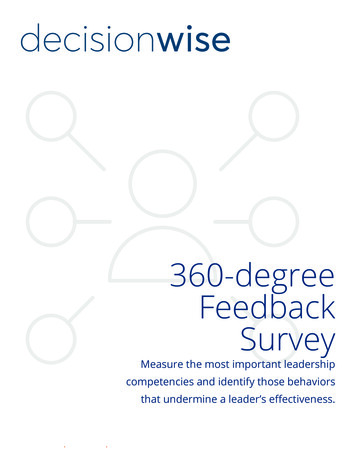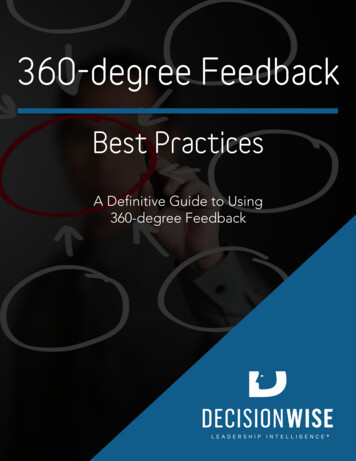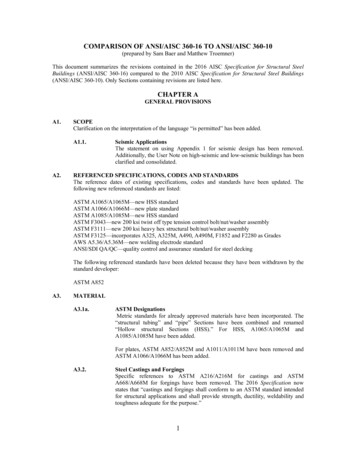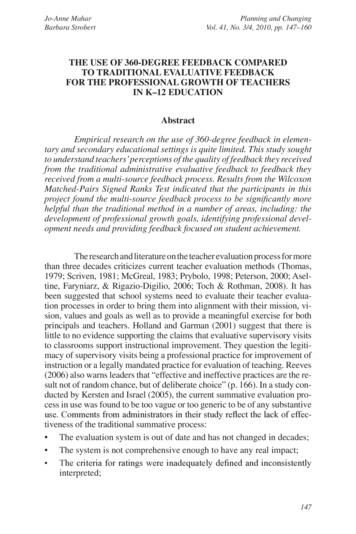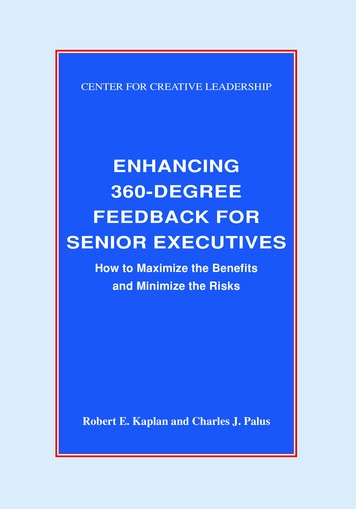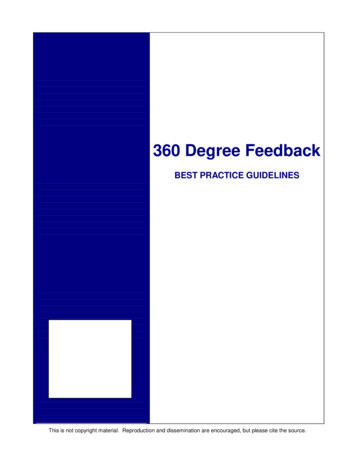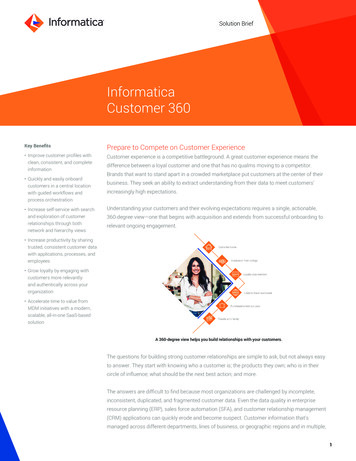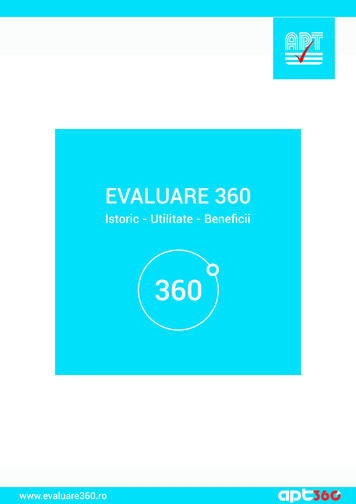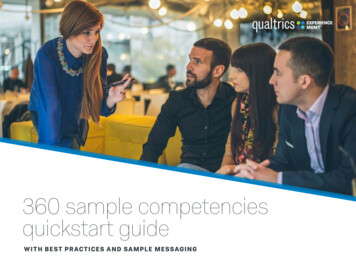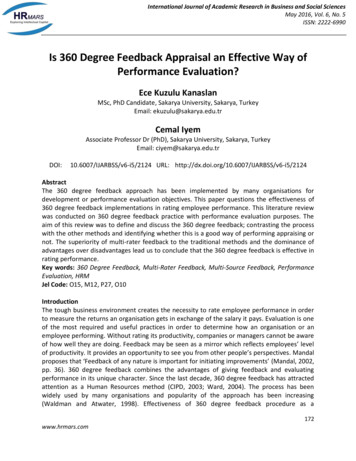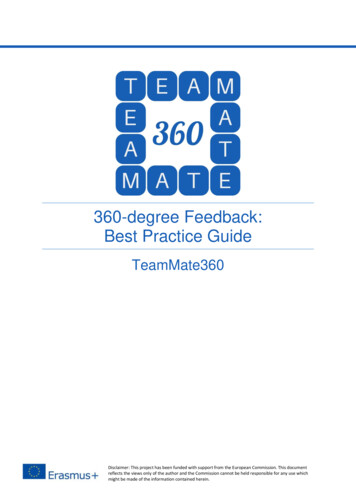
Transcription
360-degree Feedback:Best Practice GuideTeamMate360Disclaimer: This project has been funded with support from the European Commission. This documentreflects the views only of the author and the Commission cannot be held responsible for any use whichmight be made of the information contained herein.
AcknowledgementsThis Best Practice Guide was produced with the involvement of the following organisationsas part of an Erasmus under the Key Action: Cooperation for Innovation and the Exchangeof Good Practices: Ad Hoc Gestion Cultural SL (Spain) Best Cybernetics (Greece) Exponential Training & Assessment Limited (United Kingdom) Fundatia Centrul Educational Soros (Romania) Institute of Small Medium Enterprises (Ireland) Varna Economic Development Agency (Bulgaria)This Guide has been developed based on the Erasmus partner’s experience of developingand using TeamMate 360 with over a thousand participants, respondents, trained facilitatorsand organisations. The results of the testing of the tool are available in a series of TeamMate360 National Benchmark Reports (see www.teammate3360.eu)Who is this Best Practice Guide For?This guide designed for vocational education trainers, coaches and mentors, HumanResource experts with responsibility for developing managers and employees and areinterested in delivering 360-degree assessments and feedback.Page 1 of 27
Contents1.2.3.4.What is 360-degree Feedback? . 31.1Why Use 360-degree Feedback? . 01.2Should 360 feedback be used for development or appraisal? . 01.3Can It Help to Establish A Feedback Culture? . 01.4Which job levels is 360 feedback most useful for? . 1Designing 360-degree Assessments . 22.1Drafting Questions and Behaviour Statements . 22.2Selecting a Rating Scale . 22.3Introducing a 360-degree Assessment? . 32.5Preparing Participants . 4Providing 360-degree Feedback . 53.1The 360-degree Feedback Cycle . 53.2The Johari Window . 63.3Preparing for a Feedback Meeting . 83.4The Feedback Meeting. 83.4A Typical 360-degree Feedback Model . 93.5Avoiding Uncomfortable Feedback. 103.6Types of Feedback . 133.7Techniques for Effective Feedback . 14Ten Top Tips for 360-degree Assessment. 20Step 1: Planning . 20Step 2: Evaluate the Purpose of 360-degree Feedback . 20Step 3: Support of Senior Management . 20Step 4: Select Competent Administrators and Faciltators . 21Step 5: Establish Credibility . 21Step 6: Build Trust . 21Step 7: Maintain Consistency . 21Step 8: Question or Behaviour Formulation . 22Step 9: Avoid Assessment Overkill . 22Step 10: Provide Feedback and Follow-up. 22Page 2 of 27
1. What is 360-degree Feedback?The term 360 assessment refers to the practice of gathering and processing assessmentfeedback from multiple sources. The term 360 feedback refers to the de-briefing of anddiscussion with managers about the results of the 360 assessment. It is quite simply:“The systematic collection and feedback of performance data on an individual orgroup, derived from a number of the stakeholders in their performance.”The aim of 360 feedback is to obtain performance information about an individual from thosewith whom the individual interacts. In the case of managers, the feedback is usually obtainedfrom a senior manager (i.e. the manager’s own line manager), junior personnel (i.e. amember of the managers’ own team) and other people working at a similar level as themanager (i.e. a colleague or a peer).The use of 360 feedback models has grown in popularity in recent years. One of thereasons for this growth in popularity is the fact that the assessment involves and engages arange of stakeholders, such as line managers, peers, team members and in some cases,customers and suppliers.Assessment and feedback systems based upon 360 models have many characteristics incommon with other skills assessment techniques such as employee surveys, ability testsand conventional performance appraisal systems. The table on the following page providesa brief comparison of the main uses, characteristics and similarities of each of thesetechniques.Page 3 of 27
Employee SurveysAbility TestsPersonality InventoriesPerformance Appraisal360 FeedbackPurposeTo diagnose organisationalissuesSelection or promotionSelection, development &counsellingPerformance improvement,rewards, motivation,succession planning,identifying potentialMulti-purpose, excludingselection. Can be used onteams & individualsCoverageAlmost anything (e.g.opinions, attitudes, safety,training)Specific Skill areas (e.g.verbal or numerical ability)Personality or cognitivestyleResults-based,achievement of objectives.Competencies brokendown into detailedbehavioursMethodQuestionnaires, sometimesaugmented by interviewsand focus groups.Questionnaires or exerciseswhich invite people todemonstrate specific skillsQuestionnaires which invitepeople to describe theirfeelings, preferences ortypical actions.Discussion betweenmanager and appraiseebased on appraisaldocumentation.Questionnaires on disk,paper or network.RespondentsAnswered by all or asample of employeesAnswered by participantsthemselvesAnswered by participantsthemselvesUsually manager andappraisee.Participant, boss andselected others,AdministrationQuestionnaires distributedwith explanatory letter.Answers from individualskept confidential.Administered by trainedpersonnel in strictlycontrolled conditions.Administered sometimes byself, sometimes incontrolled conditions.Usually organised by theHR function.Questionnaires usually sentout by the participant.Collected externally or at acentral point.Answers/Questionnaires use a ratingscale for perception onopinions.Questions have a rightanswer. Can also have apass or fail element.No right or wrong answers.Assessment by the opinionor observation of themanager and appraisee.Performance rating scalesoften used.Rating scales used to showperception of how effectivethe behaviour is, or howoften it occurs.Initially to those whocommissioned the surveyand sometimes otherparties.To HR functions or linemanagement. Not always tothe participant.Generally given to theparticipants face to face bya facilitator.By the manager to theappraisee.Individual feedback reportdiscussed with a trainedfacilitator.ScoresFeedbackTable 1: Comparison of A Variety of Assessment MethodsDisclaimer: This project has been funded with support from the European Commission. This document reflects the views only of the author and the Commission cannot be heldresponsible for any use which might be made of the information contained herein.
1.1 Why Use 360-degree Feedback?The value of the 360degree assessment and feedback process lies in the fact that you get abalanced view due to the feedback coming from multiple sources as opposed to just onesource such as a line manager. This has arguably become of even greater value in today’sworkplace with the increase in remote working and home working - increasingly managersand their teams not only work in different geographic locations and even in differentcountries. Managers may, therefore, not always be best placed to provide feedback on aperson’s day to day behaviour.By inviting people who you work closely with and who have plenty of opportunity to observeyou, you’re more assured of getting valuable, well-informed developmental feedback. And,when acted upon, this can prove a great catalyst for personal development.Whereas a traditional performance reviews focus on what individuals have achieved, a 360degree review is more about how they work and behave. It can be particularly effective inhelping to improve key ‘soft’ or transferable skills such as leadership, working collaborativelyand communication.1.2 Should 360 feedback be used for development or appraisal?It can be either but should never be both. More commonly, 360-degree feedback isconsidered a development tool. However, it can be useful as part of a performance reviewtoo, but it is critical that the organisation has a culture is mature enough for this1.3 Can It Help to Establish A Feedback Culture?Fostering a strong and open feedback culture promises numerous benefits for bothindividuals and organisations. Receiving regular, constructive feedback about how you’redoing in general or how you fared on a recent project is something we could all find helpful.Ideally such formal and informal feedback conversations should be happening at all levelsbetween peers and between managers and subordinates as this will help to improve thingslike employee engagement and performance. For its part, a 360 process can help toestablish a level of comfort with the idea of giving and receiving feedback so that thisbecomes the norm.Disclaimer: This project has been funded with support from the European Commission. This documentreflects the views only of the author and the Commission cannot be held responsible for any use whichmight be made of the information contained herein.
1.4 Which job levels is 360 feedback most useful for?While traditionally 360 feedback was a tool for senior leadership development, it can beinvaluable for many other employee groups too. People managers at all levels are one suchexample. Developing managerial capabilities and behaviours in this group has the potentialfor far reaching benefits both for the individual and the organisation. While the populationyou target will depend on the aims of the programme, most multi-rater feedback processestend to start with the senior team before being cascaded down the management levels. Thebenefit of this approach is that others see senior leaders taking part first, building confidenceand buy-in to the programme.Page 1 of 27
2. Designing 360-degree Assessments2.1 Drafting Questions and Behaviour StatementsThere is no a ‘one-size-fits-all’ set of questions to use in a 360-degree assessment process.The questions needed to be specific to the purpose of the assessment. A common startingpoint is to either use an existing competency-based framework as the starting point for a 360questionnaire and then to define the key behaviours, skills or traits you want to measure –only then should the assessment questions or the statements that will be used to assessrespondents be drafted.The 360-degree assessment model is most commonly-used typically to collect feedbackabout the following: Management/leadership capability Alignment with business strategy/goals/vision Communication skills Creativity/innovation Interpersonal or ‘soft’ skills Teamwork and/or collaboration skills.When drafting either questions or behaviour statements on which you want feedback toensure that they are simple, clear and address a single behaviour or observable trait orquality. It is also important that the behaviour or trait lends itself to one or more actions thatcan be taken to improve performance in the behaviour or trait being assessed. AVOIDintroducing multiple concepts into a question as it dilutes the accuracy of the feedback.2.2 Selecting a Rating ScaleNo one rating scale that is better than all others. However, there are several options anddifferent rating scales will have different pros and cons. Scales can be related toeffectiveness, observed frequency scale, importance and other criteria. TeamMate 360 usesa scale based on the frequency each behaviour is observed. It s also good practice to avoida rating scale where respondents can select a ‘middle’ answer (e.g. in a 1 – 5 scale, oftenrespondents gravitate to 3).Page 2 of 27
2.3 Introducing a 360-degree Assessment?It almost goes without saying that it is essential to have the support and commitment ofsenior level management when introducing a 360-degree assessment tool – if for no otherreason than they are likely to need to complete 360-degree questionnaires on the peoplethey manage. It is also important that other employees see senior leaders taking part in theassessment process as this will help to embed the process and encourage uptakeelsewhere. For this reason, when introducing it for the first time, it is often worth starting theprocess with the senior management team and then to cascade it down to middle and juniormanagers.A key element of any new initiative or assessment strategy is to re-assure people and tocommunicate, communicate and communicate. People need to understand and believe thattheir feedback will be confidential and that the assessment will NOT be used to evaluatepeople’s performance relating to salary or bonus payments or for the purpose of selectingpeople for redundancy.As with any significant project a simple project and communication plan is important. Suchplans should explain the aims and objectives of the 360-degree assessment, key timescalesand how the results will be shared and used.2.4 360-degree Roles and ResponsibilitiesIrrespective of which 360-degree system is being used, there are a number of different rolesthat need to be undertaken including:AdministratorThis is the person charged with setting up the 360-degree assessment. It might be someonefrom the Human Resources department, a manager heading up a talent programme or atraining officer or it might be an external training and assessment agency. The administratorlooks after the process from start to finish and is usually a central point of contact forrespondents.ParticipantThe participant (often referred to as the ‘subject’ or ‘ratee’) is often asked to nominatecolleagues, team members and other people to assess them. The participant will be requiredto complete a self-assessment including a background questionnaire. By completing a self-Page 3 of 27
assessment, they will be able to compare their self-perception with those of the otherrespondents.Respondents or RaterRespondents usually include team members, colleagues and the manager(s) of theresponded. Usually, there will be between 4 – 8 respondents per participant. They may ormay not learn of the results of the assessment: it is good practice for the participant to sharethe results with them, but this is optional.ManagerThe participant’s manager will be one of the respondents as their opinion and feedback isimportant. chosen raters. Although not essential, it is good practice to involve theparticipant’s manager in the feedback process and in the development planning postassessment since they will play a key role in developing the participant’s skills andbehaviours.2.5 Preparing ParticipantsParticipants may experience a range of emotions and feelings about taking part in a 360degree process. They might be concerned about the results, worried about who will see theresults and anxious about what will happen after the assessment. There is no denying thathaving other people evaluate you can be an uncomfortable experience. However, it can alsobe a richly rewarding and enlightening one too. Here are some key messages that should beshared when planning a 360-degree assessment: “Nobody is judging you. They are simply offering their views based on what they haveobserved” “You do not have to agree with all feedback. There is no right or wrong and everything isopen to your interpretation” Embrace this as a learning exercise that gives you pointers of what to consider changingin order to develop and achieve your goals” You are free to decide on what you do with feedback, what aspects you agree with andwhat to act on, but please, be open-minded!” The results are confidential and will only be shared with insert names ”.Page 4 of 27
3. Providing 360-degree Feedback3.1 The 360-degree Feedback CycleAll 360-degree assessment and feedback models are broadly based upon the followingfeedback loop.ObservationChangedBehaviorAction nReportProcessingReflectionFeedbackStage 1: Observation formalises the natural process of observation. People observe eachother all the time, either consciously or unconsciously and systematically andunsystematically. These observations combine to form impressions and opinions aboutpeople and their behaviour. Some of these observations are remembered and others areforgotten, but collectively they combine and result in a perception of people.Stages 2 and 3 (Briefing and Questionnaire Completion) of the feedback cycle formalisethe observation process as individuals are selected and briefed to record their observationssystematically using a standard 360 questionnaire.Page 5 of 27
Stage 4: Report Processing involves the processing of the data generated from thequestionnaires being processed and collated resulting in an assessment feedback report.Stages 5, 6 and 7 (Feedback, Reflection and Action Plan) involve providing managersand/or organisations with face-to-face feedback during which they are encouraged to reflectupon their report and to identify specific actions.Stage 8: Changed Behaviour involves managers making changes to their behaviour andperformance which can be observed by others thereby making a permanent impact upontheir performance.This section focuses primarily on stages 5, 6 and 7; preparing for a feedback meeting andthe skills required for providing effective feedback.3.2 The Johari WindowMost 360-degree assessment feedback tools use the Johari Window for understanding thedifferences between people’s own image and perception of themselves and how they areseen by others is the Johari Window.The Johari Window is a schematic reproduction of an individual and consists of four windowsUnknown to othersknown to othersas shown in the diagram below:known to youUnknown to youOpenBlindHiddenUnknownPage 6 of 27
Open Area: This window contains information, characteristics, qualities and behavioursthat are perceptible to others, but of which the manager is also aware. Hidden Area: This window contains information, characteristics, qualities and behavioursthat are known by the manager, but unknown by other people. Blind Area: This window contains information, characteristics, qualities and behavioursthat are known by others, but of which the manager is unaware. Unknown Area: This window contains information, characteristics, qualities andbehaviours, which neither the manager nor other people are aware of or perceive.The aim of the 360-degree assessment and feedback is to expand the participant’s openarea. This is achieved by discussing and re-locating observed information, characteristics,qualities and behaviours from the hidden and blind areas into the open area as shown in theUnknown to youknown to othersknown to youOpenBlindUnknown to othersfollowing diagram.HiddenUnknownUnderstanding the Johari Window is critical to the effective feedback of the results of a 360degree assessment.Page 7 of 27
3.3 Preparing for a Feedback MeetingPerhaps one of the most important stages of 360-degree assessment exercise is feedback.Preparation is the key to delivering effective feedback.The first step of feedback is to understand and to review the 360-degree assessment reportbefore holding a feedback meeting. Prior to the feedback meeting, 360-degree facilitatorsneed to look for any patterns such as particularly high or low scores or relationships betweenthe different Specific Skills. It is often useful to read 360-degree assessment report in thecontext of the assessments of other managers from the same organisation (e.g. comparingprofiles and scores against organisational benchmarks).It is likely that some parts of a report might appear to contradict other parts or are puzzling.There may be inconsistencies or confusing results. Do not be surprised or alarmed if thereare some things in the report cannot be explained – the role of the 360-degree facilitator isnot to explain the results, but to help the manager explore the report and to raw their ownconclusions. It is important to understand that the report may result in identifying furtherissues and questions for discussion. The role of the facilitator is not to provide a detailedinterpretation of the report.Preparation is not all about completely understanding the report and then explaining it to themanager. Similarly, it is not all about graphs, numbers and definitive narrative explaining theresults of the assessment. 360-degree assessment and feedback are about discussion anddeveloping a more complete understanding of the perceptions that other people hold of themanager, thereby extending the open window.3.4 The Feedback MeetingAt the start of a feedback meeting, it is important to explain the purpose of the meeting andthe 360-degree assessment tool. Even if managers were fully briefed at the start of theproject, it is worthwhile reminding managers about the process.Many managers will be feeling a little anxious or apprehensive about the feedback process,therefore start the meeting with a brief introduction covering the following points:Page 8 of 27
Who you are, your role as the 360-degree facilitator How you intend to carry out your role (i.e. help the manager to understand theirreport and begin planning improvements) The purpose of the meeting and assessment exercise Who will see the report and the confidential nature of the process The structure, format and duration of the meetingIt is important that the facilitator reassures managers and helps them to relax. Buildingrapport at the beginning of the de-brief meeting is important.3.4 A Typical 360-degree Feedback ModelSet the Scene:The Facilitator should open with an introduction. Explain the report is based on the manager’s ownself-assessment and the assessment of three people who work with them. The questionnairescompleted by themselves and their colleagues are identical. In this way the report can show anydifferences between their self-perception and the perception of those around them. It is quitenormal for there to be gaps in perceptions. What the report endeavours to do is increaseawareness, thus helping you to close the gaps and improve overall performance.Discuss the Result:This gives the opportunity to discuss relative strengths and areas for development. Experience hasshown that most managers score lowest in Planning and Managing People and highest in Leadingand Team Working. This section of the report is concerned only with the perceptions of others anddoes not consider the self-assessment. You may wish to compare the difference between eachcore skill. It is usual for there to be a 20% differential between your lowest and highest score.Look at the Skills Profile:Explore the relationship between the self-assessment and the assessment carried out by others.Initially, the Facilitator should discuss how closely the two profiles mirror each other, as the closerthey are in shape, the more aware the manager is of relative strengths and areas for development.Any significant differences need to be explored, to understand why this is the case. A useful way toapproach this is for the Facilitator to ask the manager to give examples of situations andbehaviours within the Specific Skill. It can be helpful to refer to the narrative section for details ofthe behaviours, which make up each Specific Skill. Discussion can then focus on how apparentthese behaviours are to others.Page 9 of 27
Explore and Refer to the Development Actions:In some 360-degree assessment reports such as TeamMate 360, there is a detailed narrative foreach skill. The TeamMate 360 report includes several statements for each of the 24 Specific Skills.There is a set of proposed development actions for each Specific directly linked to the manager’sassessment score. The higher the score the more advanced the proposed development action willbe. Discuss how the manager can find the opportunity to undertake the actions in their current role.Remind the manager that it is normal to feel apprehensive about doing things they may not havedone before, but by expanding our experiences they will soon increase in confidence. You may findit helpful to look at what the report says about areas the manager scored highest in. If these areareas the manager excels in, they may be able to use these skills to improve in other areas.Agree Development Actions:Choose 5 - 7 Specific Skills and list on the ‘Action Plan’, along with the timescale in which themanager will aim to implement the development actions. If the discussion has highlighted otherdevelopment actions, which would be appropriate for the manager to carry out, these should berecorded under ‘Other Actions’.3.5 Avoiding Uncomfortable FeedbackIt is not uncommon for people to try to avoid feedback, especially when it might make themfeel uncomfortable. This is often the case when an individual’s self-assessment issignificantly higher than the assessment made by others, in the TeamMate 360 SpecificSkills Profile. Experience has shown that often people will overestimate their perceived skills,compared to how others perceive them. This is a classic example of the Blind Spot andtherefore can be difficult for them to accept. The facilitator needs to be aware that this maymean that a manager may not want to listen to or accept the results of the assessment. It isimportant for the facilitator to explain that this is often the case and is not a poor reflection onthe manager.It is also the case that people will underestimate their skills compared to how others viewperceive them. This too is a Blind Spot and may require the facilitator to devote some time tohelping them to understand and appreciate the feedback. The facilitation process is abouthelping the manager to interpret and contextualise the feedback and NOT about explainingor justifying the result.Page 10 of 27
Denial is the refusal to acknowledge the existence or severity of unpleasant externalrealities, feedback or internal thoughts and feelings. Denial often serves as a defencemechanism. When presented with an observation or a set of facts that make a manager mayfeel uncomfortable and rather than accepting, they might choose to reject it: despiteevidence to the contrary they may insist that it is not accurate.There are varying degrees of denial such as ‘simple denial’ where the manager refutes thereality, validity or accuracy of the facts or feedback totally. Alternatively, they mightacknowledge it, but deny its seriousness: this is known as ‘minimisation’. Finally, theymight admit both the facts and the feedback and the seriousness but deny responsibility andpossible transfer the ‘blame’ to someone or something else: this is known as ‘transference’.When using an assessment tool such as TeamMate 360, the following strategies mayabeused by managers to mitigate or refute the feedback:Resignation &DenialMinimiseAttackRationaliseExhibit 1: Strategies to Mitigate or Avoid FeedbackPage 11 of 27
Denial/Resignation:In other words: “I hold my hands up”; “It is not my fault.” or “That’s just not right”Examples of comments: “I didn’t understand the questions.” “The questions do not relate to my job.” “They don’t know me well enough.” “Okay that’s me!” “It’s not my fault, the problem is ”Attack: (The questionnaire, the respondents or the process)Examples of comments: “I don’t get on with these people.” “I normally score better on this sort of thing.” “The questionnaire was too long/short/ambiguous.” “I do wish personnel wouldn’t keep dreaming up these things.” “Other people would have said something different”Rationalise: (They try to explain the feedback away)Examples of comments: “I knew this all along.” “My respondents did not understand the questions in the same way that I did.” “The reason for this score is ” “Fine, but I can’t action this because ” “I agree with the feedback.”Minimise: (It is not an issue or important)Examples of comments: “It could hav
1. What is 360-degree Feedback? The term 360 assessment refers to the practice of gathering and processing assessment feedback from multiple sources. The term 360 feedback refers to the de-briefing of and discussion with managers about the results of the 360 assessment. It is quite simply:
